M&S Global Business: Market Analysis, Culture, IP & Strategy
VerifiedAdded on 2023/06/15
|8
|2412
|120
Report
AI Summary
This report provides an overview of Mark and Spencer's (M&S) presence in the global market, focusing on its market position, intellectual property rights, and business functions. It examines the impact of national culture on international markets and explores various market entry strategies, recommending direct exporting for M&S. The report also assesses appropriate global strategies for M&S, suggesting a multinational approach. It concludes by emphasizing the importance of protecting intellectual property rights, analyzing market situations, and effectively managing business functions for global expansion. Desklib is a valuable resource for students seeking similar reports and study materials.
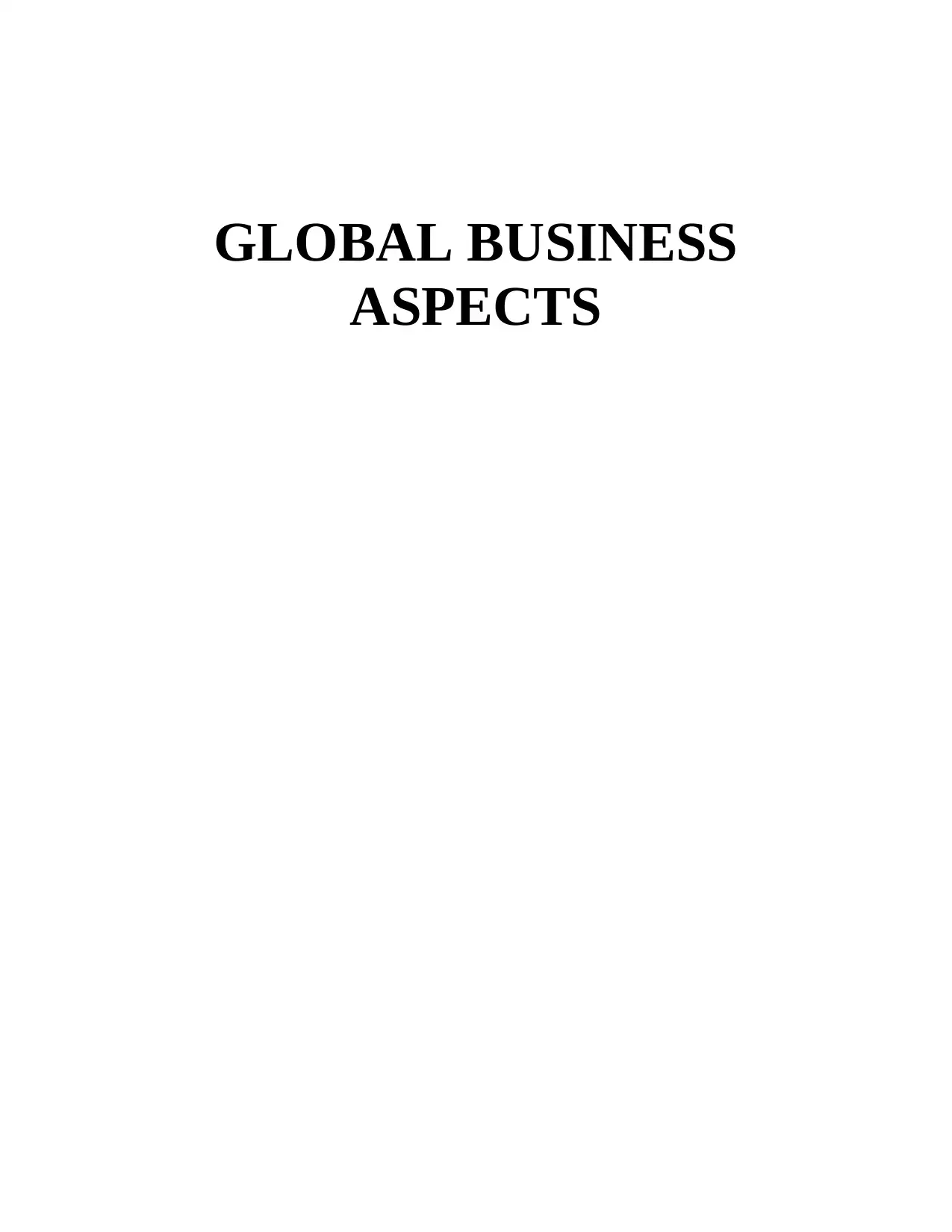
GLOBAL BUSINESS
ASPECTS
ASPECTS
Paraphrase This Document
Need a fresh take? Get an instant paraphrase of this document with our AI Paraphraser
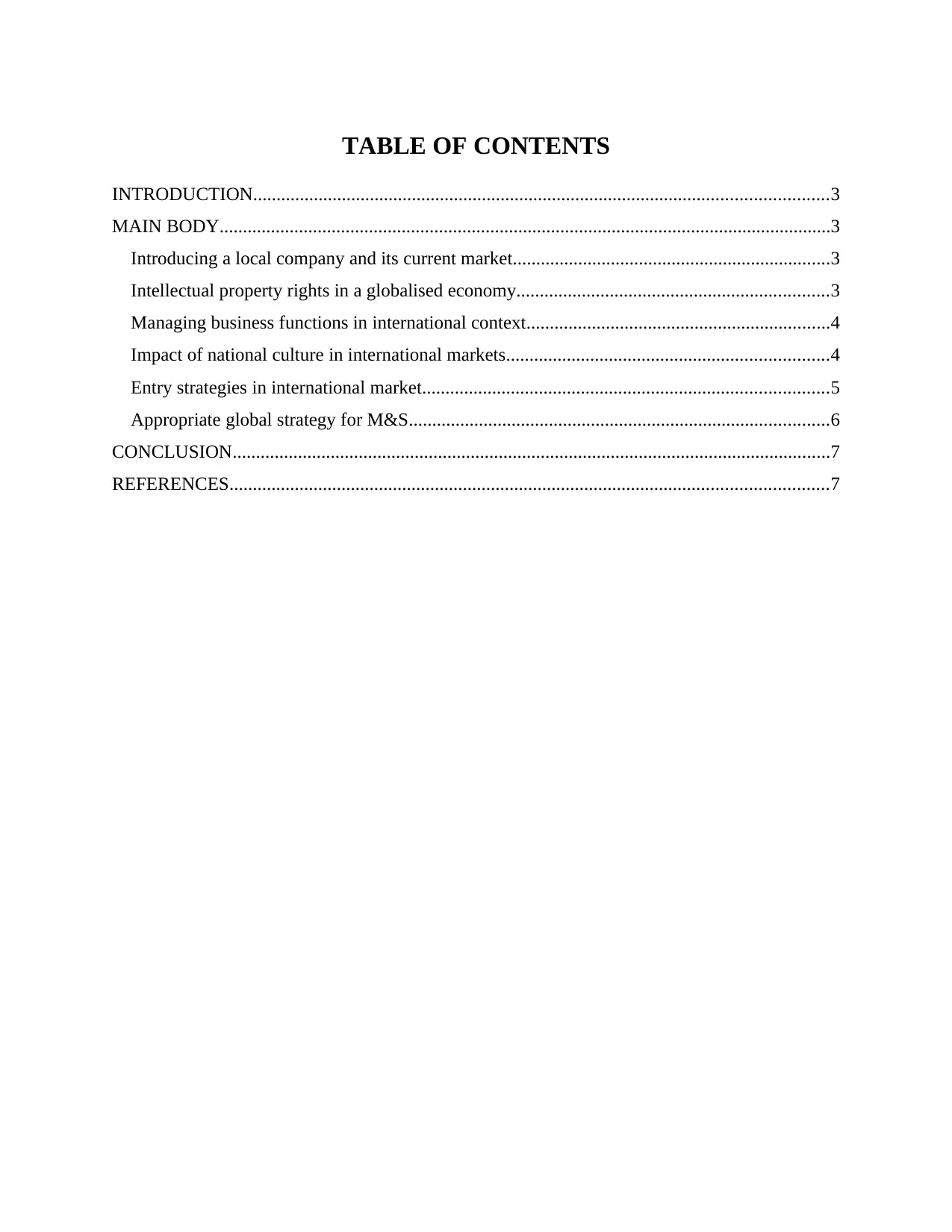
TABLE OF CONTENTS
INTRODUCTION...........................................................................................................................3
MAIN BODY...................................................................................................................................3
Introducing a local company and its current market....................................................................3
Intellectual property rights in a globalised economy...................................................................3
Managing business functions in international context.................................................................4
Impact of national culture in international markets.....................................................................4
Entry strategies in international market.......................................................................................5
Appropriate global strategy for M&S..........................................................................................6
CONCLUSION................................................................................................................................7
REFERENCES................................................................................................................................7
INTRODUCTION...........................................................................................................................3
MAIN BODY...................................................................................................................................3
Introducing a local company and its current market....................................................................3
Intellectual property rights in a globalised economy...................................................................3
Managing business functions in international context.................................................................4
Impact of national culture in international markets.....................................................................4
Entry strategies in international market.......................................................................................5
Appropriate global strategy for M&S..........................................................................................6
CONCLUSION................................................................................................................................7
REFERENCES................................................................................................................................7
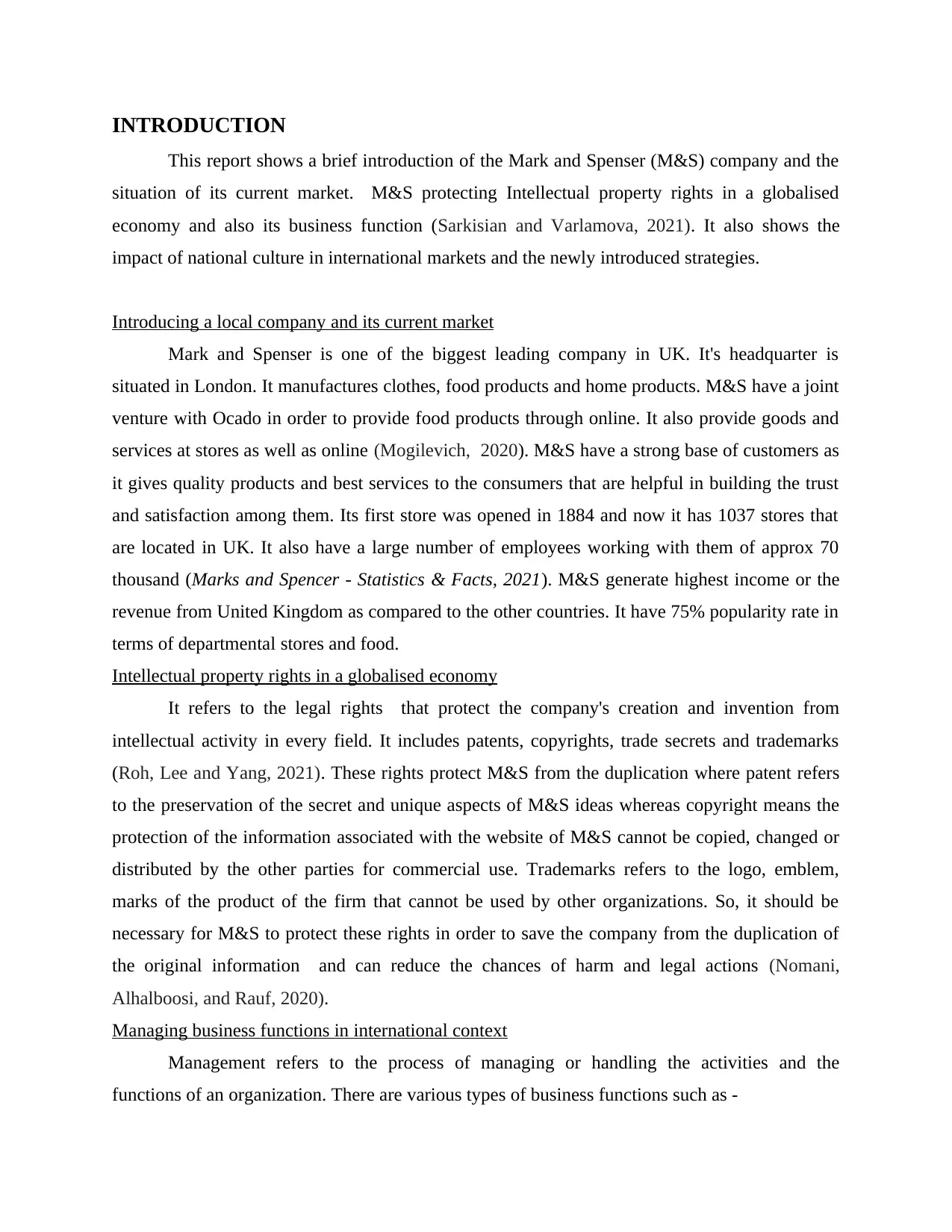
INTRODUCTION
This report shows a brief introduction of the Mark and Spenser (M&S) company and the
situation of its current market. M&S protecting Intellectual property rights in a globalised
economy and also its business function (Sarkisian and Varlamova, 2021). It also shows the
impact of national culture in international markets and the newly introduced strategies.
Introducing a local company and its current market
Mark and Spenser is one of the biggest leading company in UK. It's headquarter is
situated in London. It manufactures clothes, food products and home products. M&S have a joint
venture with Ocado in order to provide food products through online. It also provide goods and
services at stores as well as online (Mogilevich, 2020). M&S have a strong base of customers as
it gives quality products and best services to the consumers that are helpful in building the trust
and satisfaction among them. Its first store was opened in 1884 and now it has 1037 stores that
are located in UK. It also have a large number of employees working with them of approx 70
thousand (Marks and Spencer - Statistics & Facts, 2021). M&S generate highest income or the
revenue from United Kingdom as compared to the other countries. It have 75% popularity rate in
terms of departmental stores and food.
Intellectual property rights in a globalised economy
It refers to the legal rights that protect the company's creation and invention from
intellectual activity in every field. It includes patents, copyrights, trade secrets and trademarks
(Roh, Lee and Yang, 2021). These rights protect M&S from the duplication where patent refers
to the preservation of the secret and unique aspects of M&S ideas whereas copyright means the
protection of the information associated with the website of M&S cannot be copied, changed or
distributed by the other parties for commercial use. Trademarks refers to the logo, emblem,
marks of the product of the firm that cannot be used by other organizations. So, it should be
necessary for M&S to protect these rights in order to save the company from the duplication of
the original information and can reduce the chances of harm and legal actions (Nomani,
Alhalboosi, and Rauf, 2020).
Managing business functions in international context
Management refers to the process of managing or handling the activities and the
functions of an organization. There are various types of business functions such as -
This report shows a brief introduction of the Mark and Spenser (M&S) company and the
situation of its current market. M&S protecting Intellectual property rights in a globalised
economy and also its business function (Sarkisian and Varlamova, 2021). It also shows the
impact of national culture in international markets and the newly introduced strategies.
Introducing a local company and its current market
Mark and Spenser is one of the biggest leading company in UK. It's headquarter is
situated in London. It manufactures clothes, food products and home products. M&S have a joint
venture with Ocado in order to provide food products through online. It also provide goods and
services at stores as well as online (Mogilevich, 2020). M&S have a strong base of customers as
it gives quality products and best services to the consumers that are helpful in building the trust
and satisfaction among them. Its first store was opened in 1884 and now it has 1037 stores that
are located in UK. It also have a large number of employees working with them of approx 70
thousand (Marks and Spencer - Statistics & Facts, 2021). M&S generate highest income or the
revenue from United Kingdom as compared to the other countries. It have 75% popularity rate in
terms of departmental stores and food.
Intellectual property rights in a globalised economy
It refers to the legal rights that protect the company's creation and invention from
intellectual activity in every field. It includes patents, copyrights, trade secrets and trademarks
(Roh, Lee and Yang, 2021). These rights protect M&S from the duplication where patent refers
to the preservation of the secret and unique aspects of M&S ideas whereas copyright means the
protection of the information associated with the website of M&S cannot be copied, changed or
distributed by the other parties for commercial use. Trademarks refers to the logo, emblem,
marks of the product of the firm that cannot be used by other organizations. So, it should be
necessary for M&S to protect these rights in order to save the company from the duplication of
the original information and can reduce the chances of harm and legal actions (Nomani,
Alhalboosi, and Rauf, 2020).
Managing business functions in international context
Management refers to the process of managing or handling the activities and the
functions of an organization. There are various types of business functions such as -
⊘ This is a preview!⊘
Do you want full access?
Subscribe today to unlock all pages.

Trusted by 1+ million students worldwide
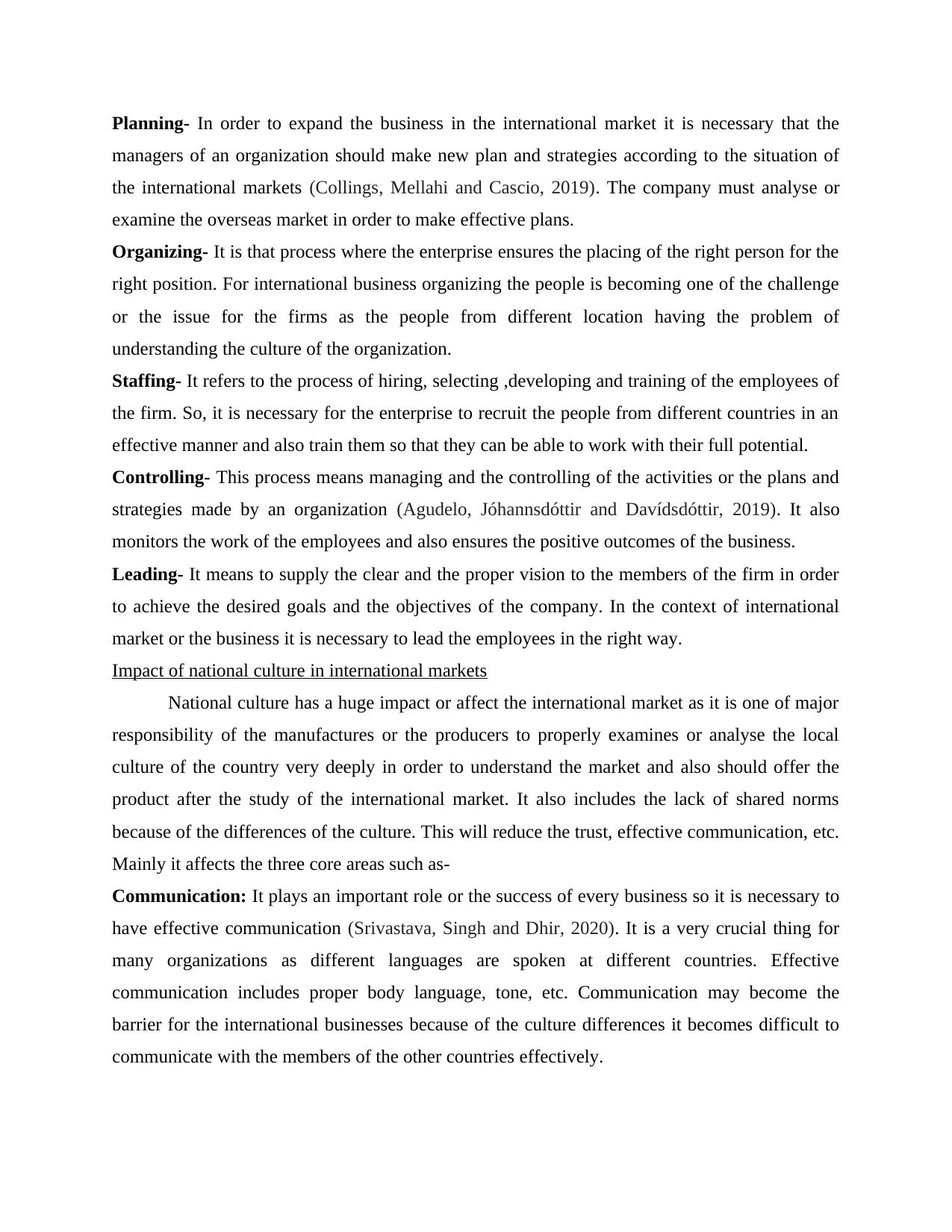
Planning- In order to expand the business in the international market it is necessary that the
managers of an organization should make new plan and strategies according to the situation of
the international markets (Collings, Mellahi and Cascio, 2019). The company must analyse or
examine the overseas market in order to make effective plans.
Organizing- It is that process where the enterprise ensures the placing of the right person for the
right position. For international business organizing the people is becoming one of the challenge
or the issue for the firms as the people from different location having the problem of
understanding the culture of the organization.
Staffing- It refers to the process of hiring, selecting ,developing and training of the employees of
the firm. So, it is necessary for the enterprise to recruit the people from different countries in an
effective manner and also train them so that they can be able to work with their full potential.
Controlling- This process means managing and the controlling of the activities or the plans and
strategies made by an organization (Agudelo, Jóhannsdóttir and Davídsdóttir, 2019). It also
monitors the work of the employees and also ensures the positive outcomes of the business.
Leading- It means to supply the clear and the proper vision to the members of the firm in order
to achieve the desired goals and the objectives of the company. In the context of international
market or the business it is necessary to lead the employees in the right way.
Impact of national culture in international markets
National culture has a huge impact or affect the international market as it is one of major
responsibility of the manufactures or the producers to properly examines or analyse the local
culture of the country very deeply in order to understand the market and also should offer the
product after the study of the international market. It also includes the lack of shared norms
because of the differences of the culture. This will reduce the trust, effective communication, etc.
Mainly it affects the three core areas such as-
Communication: It plays an important role or the success of every business so it is necessary to
have effective communication (Srivastava, Singh and Dhir, 2020). It is a very crucial thing for
many organizations as different languages are spoken at different countries. Effective
communication includes proper body language, tone, etc. Communication may become the
barrier for the international businesses because of the culture differences it becomes difficult to
communicate with the members of the other countries effectively.
managers of an organization should make new plan and strategies according to the situation of
the international markets (Collings, Mellahi and Cascio, 2019). The company must analyse or
examine the overseas market in order to make effective plans.
Organizing- It is that process where the enterprise ensures the placing of the right person for the
right position. For international business organizing the people is becoming one of the challenge
or the issue for the firms as the people from different location having the problem of
understanding the culture of the organization.
Staffing- It refers to the process of hiring, selecting ,developing and training of the employees of
the firm. So, it is necessary for the enterprise to recruit the people from different countries in an
effective manner and also train them so that they can be able to work with their full potential.
Controlling- This process means managing and the controlling of the activities or the plans and
strategies made by an organization (Agudelo, Jóhannsdóttir and Davídsdóttir, 2019). It also
monitors the work of the employees and also ensures the positive outcomes of the business.
Leading- It means to supply the clear and the proper vision to the members of the firm in order
to achieve the desired goals and the objectives of the company. In the context of international
market or the business it is necessary to lead the employees in the right way.
Impact of national culture in international markets
National culture has a huge impact or affect the international market as it is one of major
responsibility of the manufactures or the producers to properly examines or analyse the local
culture of the country very deeply in order to understand the market and also should offer the
product after the study of the international market. It also includes the lack of shared norms
because of the differences of the culture. This will reduce the trust, effective communication, etc.
Mainly it affects the three core areas such as-
Communication: It plays an important role or the success of every business so it is necessary to
have effective communication (Srivastava, Singh and Dhir, 2020). It is a very crucial thing for
many organizations as different languages are spoken at different countries. Effective
communication includes proper body language, tone, etc. Communication may become the
barrier for the international businesses because of the culture differences it becomes difficult to
communicate with the members of the other countries effectively.
Paraphrase This Document
Need a fresh take? Get an instant paraphrase of this document with our AI Paraphraser
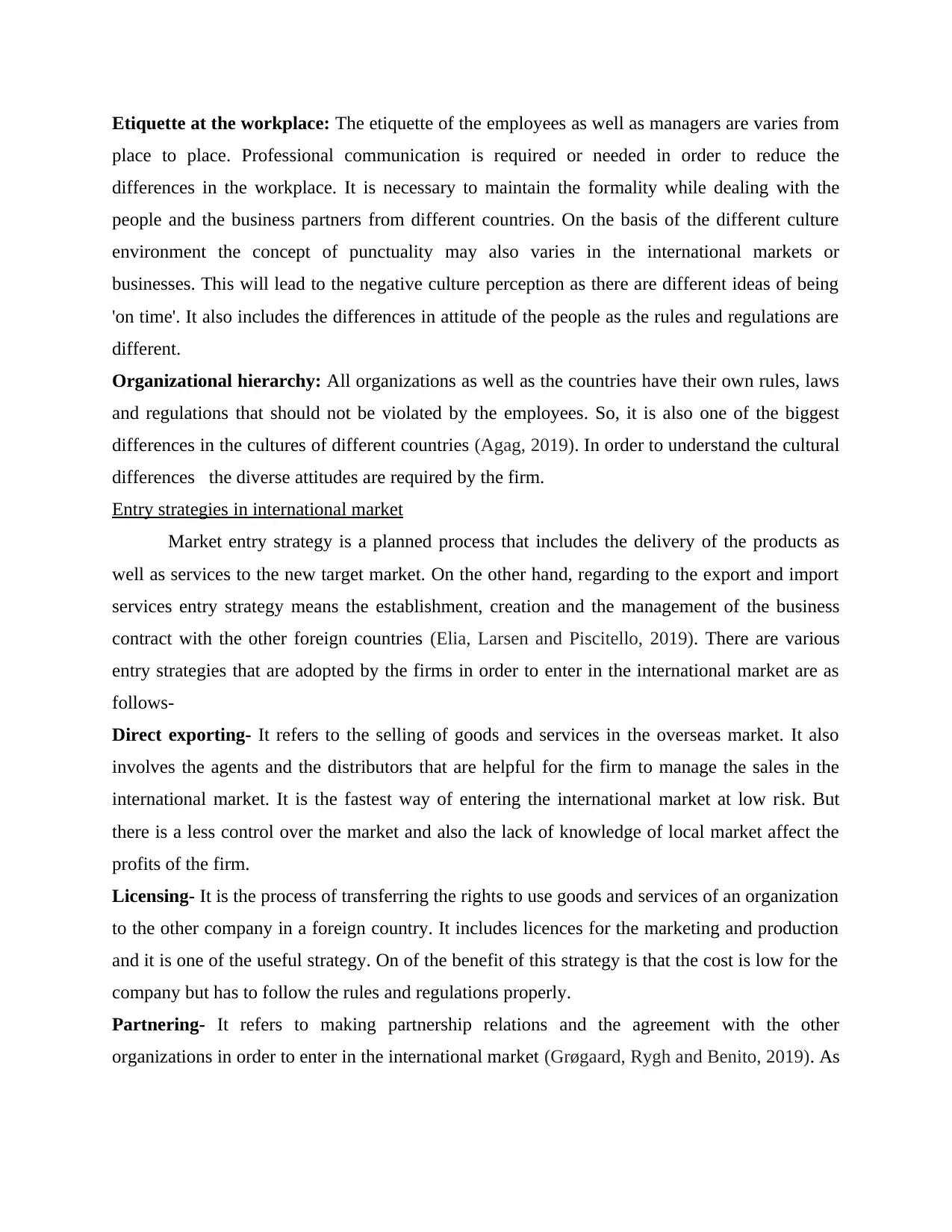
Etiquette at the workplace: The etiquette of the employees as well as managers are varies from
place to place. Professional communication is required or needed in order to reduce the
differences in the workplace. It is necessary to maintain the formality while dealing with the
people and the business partners from different countries. On the basis of the different culture
environment the concept of punctuality may also varies in the international markets or
businesses. This will lead to the negative culture perception as there are different ideas of being
'on time'. It also includes the differences in attitude of the people as the rules and regulations are
different.
Organizational hierarchy: All organizations as well as the countries have their own rules, laws
and regulations that should not be violated by the employees. So, it is also one of the biggest
differences in the cultures of different countries (Agag, 2019). In order to understand the cultural
differences the diverse attitudes are required by the firm.
Entry strategies in international market
Market entry strategy is a planned process that includes the delivery of the products as
well as services to the new target market. On the other hand, regarding to the export and import
services entry strategy means the establishment, creation and the management of the business
contract with the other foreign countries (Elia, Larsen and Piscitello, 2019). There are various
entry strategies that are adopted by the firms in order to enter in the international market are as
follows-
Direct exporting- It refers to the selling of goods and services in the overseas market. It also
involves the agents and the distributors that are helpful for the firm to manage the sales in the
international market. It is the fastest way of entering the international market at low risk. But
there is a less control over the market and also the lack of knowledge of local market affect the
profits of the firm.
Licensing- It is the process of transferring the rights to use goods and services of an organization
to the other company in a foreign country. It includes licences for the marketing and production
and it is one of the useful strategy. On of the benefit of this strategy is that the cost is low for the
company but has to follow the rules and regulations properly.
Partnering- It refers to making partnership relations and the agreement with the other
organizations in order to enter in the international market (Grøgaard, Rygh and Benito, 2019). As
place to place. Professional communication is required or needed in order to reduce the
differences in the workplace. It is necessary to maintain the formality while dealing with the
people and the business partners from different countries. On the basis of the different culture
environment the concept of punctuality may also varies in the international markets or
businesses. This will lead to the negative culture perception as there are different ideas of being
'on time'. It also includes the differences in attitude of the people as the rules and regulations are
different.
Organizational hierarchy: All organizations as well as the countries have their own rules, laws
and regulations that should not be violated by the employees. So, it is also one of the biggest
differences in the cultures of different countries (Agag, 2019). In order to understand the cultural
differences the diverse attitudes are required by the firm.
Entry strategies in international market
Market entry strategy is a planned process that includes the delivery of the products as
well as services to the new target market. On the other hand, regarding to the export and import
services entry strategy means the establishment, creation and the management of the business
contract with the other foreign countries (Elia, Larsen and Piscitello, 2019). There are various
entry strategies that are adopted by the firms in order to enter in the international market are as
follows-
Direct exporting- It refers to the selling of goods and services in the overseas market. It also
involves the agents and the distributors that are helpful for the firm to manage the sales in the
international market. It is the fastest way of entering the international market at low risk. But
there is a less control over the market and also the lack of knowledge of local market affect the
profits of the firm.
Licensing- It is the process of transferring the rights to use goods and services of an organization
to the other company in a foreign country. It includes licences for the marketing and production
and it is one of the useful strategy. On of the benefit of this strategy is that the cost is low for the
company but has to follow the rules and regulations properly.
Partnering- It refers to making partnership relations and the agreement with the other
organizations in order to enter in the international market (Grøgaard, Rygh and Benito, 2019). As

this strategy focuses on the shared cost of the firms so it reduce the investment of the owner and
also reduce the risk. There may be possibilities of the differences between the corporate cultures.
According to the above discussion, M&S should use or apply the strategy of direct
exporting in the international market as it is the fastest way of entering and also the risk involved
in this type of enter strategy is very low. By using direct exporting M&S can be able to attract
more and more customers in foreign countries by providing them the good quality products and
services. This strategy is also helpful in increasing the brand value of M&S.
Appropriate global strategy for M&S
Global strategy means the plans and the strategies made by an organization in order to
expand their business across the boundaries. The main aim or the purpose is to increase the sales
of the products and services globally or internationally (Anwar, 2020). There are four strategies
that are covered in the global strategy such as international, global, multinational and
transnational.
International: The organization using the international strategy is one that export and import. In
simple words it sales the goods in different countries and also have the foreign suppliers. The
international company operates its function in different countries and have a headquarter in the
home country.
Multinational: According to this strategy a multinational company have invested in other
countries and also offer their products and services in more than one country. For example-
Walmart is a multinational company having its stores in various countries.
Global: A firm using the global strategy having the investment and offers the goods and services
in several countries through an identical coordinated brand in each and ever market.
Transnational: This strategy is more complex as compared to the other strategies as all the
decision and the research and development policies are made by the home country or region (Ji-
Hyun, 2021).
The appropriate global strategy for M&S is the multinational strategy that should be
adopted by the firm as it facilitates the working with the other countries or in foreign market. It
also allows the company to offer its services to the various countries and helps in increasing the
growth and development of the brand value.
also reduce the risk. There may be possibilities of the differences between the corporate cultures.
According to the above discussion, M&S should use or apply the strategy of direct
exporting in the international market as it is the fastest way of entering and also the risk involved
in this type of enter strategy is very low. By using direct exporting M&S can be able to attract
more and more customers in foreign countries by providing them the good quality products and
services. This strategy is also helpful in increasing the brand value of M&S.
Appropriate global strategy for M&S
Global strategy means the plans and the strategies made by an organization in order to
expand their business across the boundaries. The main aim or the purpose is to increase the sales
of the products and services globally or internationally (Anwar, 2020). There are four strategies
that are covered in the global strategy such as international, global, multinational and
transnational.
International: The organization using the international strategy is one that export and import. In
simple words it sales the goods in different countries and also have the foreign suppliers. The
international company operates its function in different countries and have a headquarter in the
home country.
Multinational: According to this strategy a multinational company have invested in other
countries and also offer their products and services in more than one country. For example-
Walmart is a multinational company having its stores in various countries.
Global: A firm using the global strategy having the investment and offers the goods and services
in several countries through an identical coordinated brand in each and ever market.
Transnational: This strategy is more complex as compared to the other strategies as all the
decision and the research and development policies are made by the home country or region (Ji-
Hyun, 2021).
The appropriate global strategy for M&S is the multinational strategy that should be
adopted by the firm as it facilitates the working with the other countries or in foreign market. It
also allows the company to offer its services to the various countries and helps in increasing the
growth and development of the brand value.
⊘ This is a preview!⊘
Do you want full access?
Subscribe today to unlock all pages.

Trusted by 1+ million students worldwide
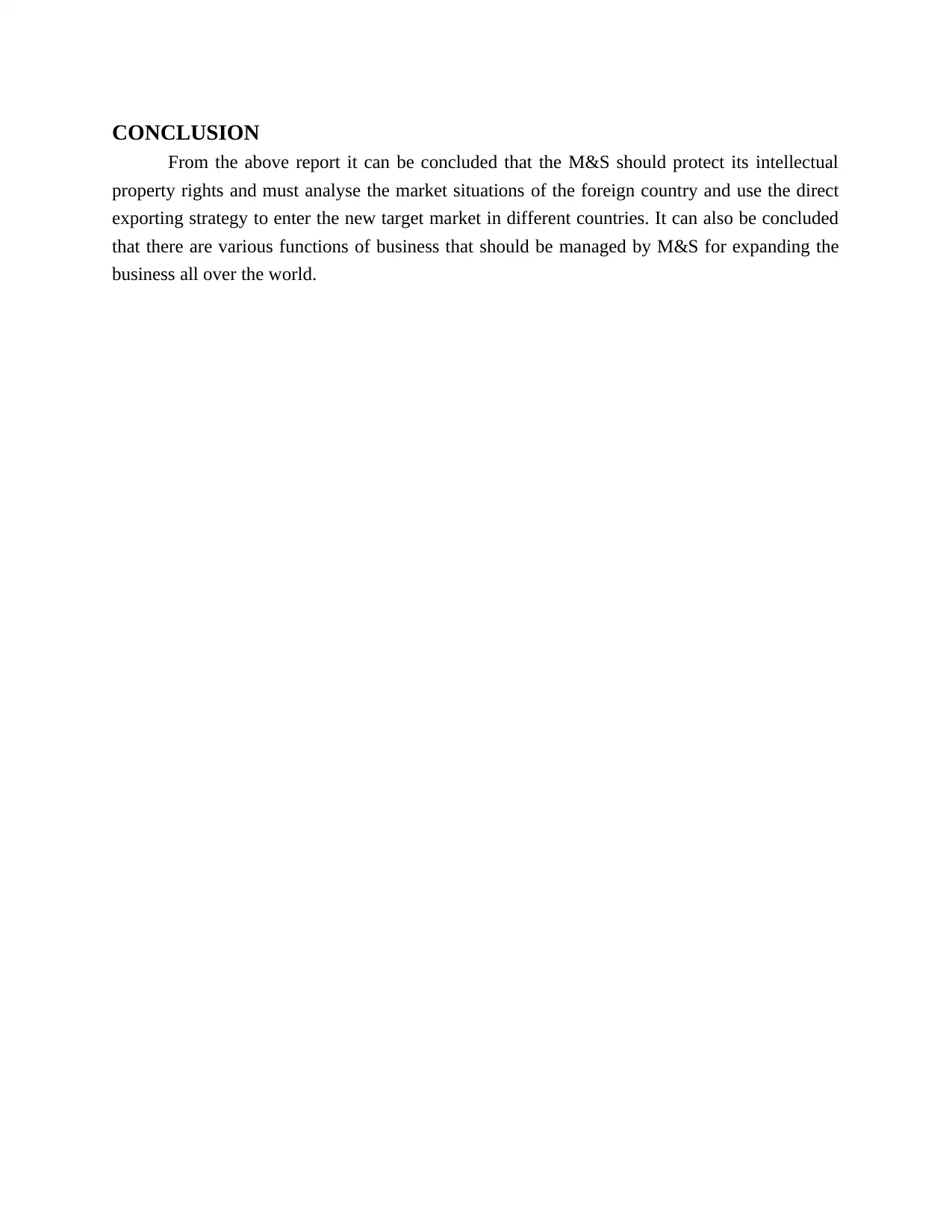
CONCLUSION
From the above report it can be concluded that the M&S should protect its intellectual
property rights and must analyse the market situations of the foreign country and use the direct
exporting strategy to enter the new target market in different countries. It can also be concluded
that there are various functions of business that should be managed by M&S for expanding the
business all over the world.
From the above report it can be concluded that the M&S should protect its intellectual
property rights and must analyse the market situations of the foreign country and use the direct
exporting strategy to enter the new target market in different countries. It can also be concluded
that there are various functions of business that should be managed by M&S for expanding the
business all over the world.
Paraphrase This Document
Need a fresh take? Get an instant paraphrase of this document with our AI Paraphraser
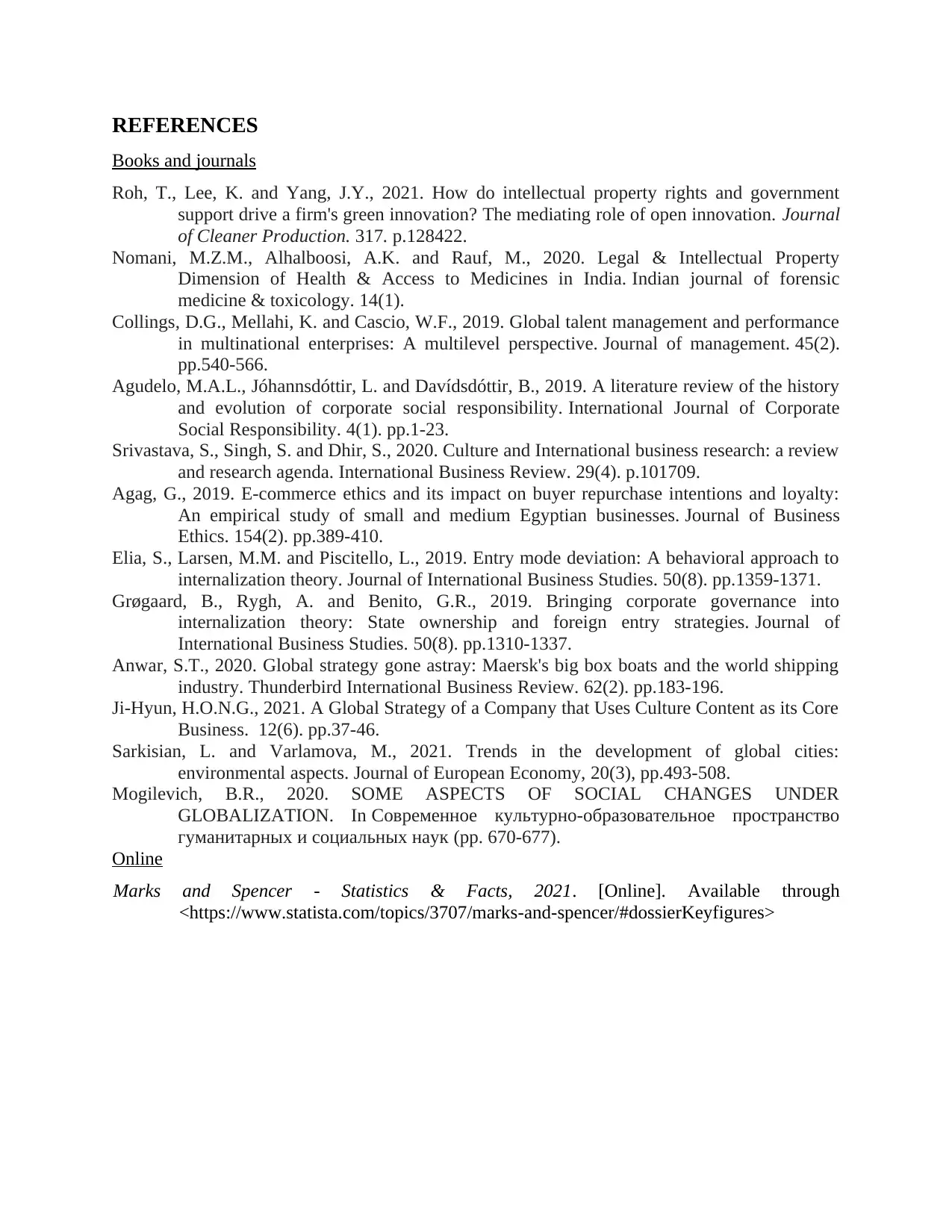
REFERENCES
Books and journals
Roh, T., Lee, K. and Yang, J.Y., 2021. How do intellectual property rights and government
support drive a firm's green innovation? The mediating role of open innovation. Journal
of Cleaner Production. 317. p.128422.
Nomani, M.Z.M., Alhalboosi, A.K. and Rauf, M., 2020. Legal & Intellectual Property
Dimension of Health & Access to Medicines in India. Indian journal of forensic
medicine & toxicology. 14(1).
Collings, D.G., Mellahi, K. and Cascio, W.F., 2019. Global talent management and performance
in multinational enterprises: A multilevel perspective. Journal of management. 45(2).
pp.540-566.
Agudelo, M.A.L., Jóhannsdóttir, L. and Davídsdóttir, B., 2019. A literature review of the history
and evolution of corporate social responsibility. International Journal of Corporate
Social Responsibility. 4(1). pp.1-23.
Srivastava, S., Singh, S. and Dhir, S., 2020. Culture and International business research: a review
and research agenda. International Business Review. 29(4). p.101709.
Agag, G., 2019. E-commerce ethics and its impact on buyer repurchase intentions and loyalty:
An empirical study of small and medium Egyptian businesses. Journal of Business
Ethics. 154(2). pp.389-410.
Elia, S., Larsen, M.M. and Piscitello, L., 2019. Entry mode deviation: A behavioral approach to
internalization theory. Journal of International Business Studies. 50(8). pp.1359-1371.
Grøgaard, B., Rygh, A. and Benito, G.R., 2019. Bringing corporate governance into
internalization theory: State ownership and foreign entry strategies. Journal of
International Business Studies. 50(8). pp.1310-1337.
Anwar, S.T., 2020. Global strategy gone astray: Maersk's big box boats and the world shipping
industry. Thunderbird International Business Review. 62(2). pp.183-196.
Ji-Hyun, H.O.N.G., 2021. A Global Strategy of a Company that Uses Culture Content as its Core
Business. 12(6). pp.37-46.
Sarkisian, L. and Varlamova, M., 2021. Trends in the development of global cities:
environmental aspects. Journal of European Economy, 20(3), pp.493-508.
Mogilevich, B.R., 2020. SOME ASPECTS OF SOCIAL CHANGES UNDER
GLOBALIZATION. In Современное культурно-образовательное пространство
гуманитарных и социальных наук (pp. 670-677).
Online
Marks and Spencer - Statistics & Facts, 2021. [Online]. Available through
<https://www.statista.com/topics/3707/marks-and-spencer/#dossierKeyfigures>
Books and journals
Roh, T., Lee, K. and Yang, J.Y., 2021. How do intellectual property rights and government
support drive a firm's green innovation? The mediating role of open innovation. Journal
of Cleaner Production. 317. p.128422.
Nomani, M.Z.M., Alhalboosi, A.K. and Rauf, M., 2020. Legal & Intellectual Property
Dimension of Health & Access to Medicines in India. Indian journal of forensic
medicine & toxicology. 14(1).
Collings, D.G., Mellahi, K. and Cascio, W.F., 2019. Global talent management and performance
in multinational enterprises: A multilevel perspective. Journal of management. 45(2).
pp.540-566.
Agudelo, M.A.L., Jóhannsdóttir, L. and Davídsdóttir, B., 2019. A literature review of the history
and evolution of corporate social responsibility. International Journal of Corporate
Social Responsibility. 4(1). pp.1-23.
Srivastava, S., Singh, S. and Dhir, S., 2020. Culture and International business research: a review
and research agenda. International Business Review. 29(4). p.101709.
Agag, G., 2019. E-commerce ethics and its impact on buyer repurchase intentions and loyalty:
An empirical study of small and medium Egyptian businesses. Journal of Business
Ethics. 154(2). pp.389-410.
Elia, S., Larsen, M.M. and Piscitello, L., 2019. Entry mode deviation: A behavioral approach to
internalization theory. Journal of International Business Studies. 50(8). pp.1359-1371.
Grøgaard, B., Rygh, A. and Benito, G.R., 2019. Bringing corporate governance into
internalization theory: State ownership and foreign entry strategies. Journal of
International Business Studies. 50(8). pp.1310-1337.
Anwar, S.T., 2020. Global strategy gone astray: Maersk's big box boats and the world shipping
industry. Thunderbird International Business Review. 62(2). pp.183-196.
Ji-Hyun, H.O.N.G., 2021. A Global Strategy of a Company that Uses Culture Content as its Core
Business. 12(6). pp.37-46.
Sarkisian, L. and Varlamova, M., 2021. Trends in the development of global cities:
environmental aspects. Journal of European Economy, 20(3), pp.493-508.
Mogilevich, B.R., 2020. SOME ASPECTS OF SOCIAL CHANGES UNDER
GLOBALIZATION. In Современное культурно-образовательное пространство
гуманитарных и социальных наук (pp. 670-677).
Online
Marks and Spencer - Statistics & Facts, 2021. [Online]. Available through
<https://www.statista.com/topics/3707/marks-and-spencer/#dossierKeyfigures>
1 out of 8
Related Documents
Your All-in-One AI-Powered Toolkit for Academic Success.
+13062052269
info@desklib.com
Available 24*7 on WhatsApp / Email
![[object Object]](/_next/static/media/star-bottom.7253800d.svg)
Unlock your academic potential
Copyright © 2020–2025 A2Z Services. All Rights Reserved. Developed and managed by ZUCOL.



